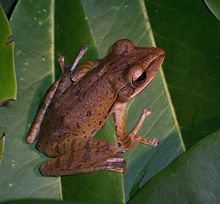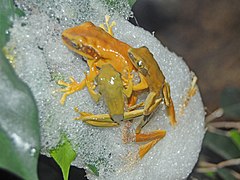Common tree frog
| Common tree frog | |
|---|---|

| |
| Common tree frog (female) | |

| |
| Adult at Darmaga (Bogor Regency, West Java, Indonesia) | |
| Scientific classification | |
| Domain: | Eukaryota |
| Kingdom: | Animalia |
| Phylum: | Chordata |
| Class: | Amphibia |
| Order: | Anura |
| Family: | Rhacophoridae |
| Genus: | Polypedates |
| Species: | P. leucomystax
|
| Binomial name | |
| Polypedates leucomystax (Gravenhorst, 1829)
| |
| Synonyms | |
| |
Polypedates leucomystax is a
Polypedates leucomystax is not considered a
Range
Previously, P. leucomystex was thought to distribute below the Red River of Vietnam and in western Yunnan, while P. megacephalus can be found above the Red River and in Northeast India.[3] However, recent genetic studies revealed that the natural barriers between these species are the Isthmus of Kra and the Tenasserim Range, where P. leucomystax can be found below the isthmus and west of the range.[4]
The Polypedates leucomystax complex began diverging during the
In Indonesia, it has been found throughout the archipelago in
4 major
- southern type locality: Java)
- northern basalclade)
- sp. nov.suggested; 4 different sub-clades have been differentiated for each of the 4 "prongs" or peninsulas of Sulawesi Island)
- basal variety from Lombok)
Divergent varieties that are either P. cf. leucomystax or
Habitat
Its natural
Description

Polypedates leucomystax can reach approximately a snout–vent length of 3.7–5.0 centimetres (1.5–2.0 in) in males, of 5.7–7.5 centimetres (2.2–3.0 in) in females.[6] Body of these rather small shrub frogs is moderately slender, ovoid, slightly flattened above, with sharply pointed tail. The skin on the upper side is smooth. The body colour is rather variable, with various shades of gray, green, yellow, reddish or dark brown. Usually it is irregularly mottled, often with four stripes along the back. The tip of snout sometimes shows a distinct white spot. Eyes are at the side of the head. The hind feet are webbed. The feet have clear, large cushions as usual with leaf frogs.[7]
Biology
In the damp areas of the propagation, these frogs are present all year round. In drier environments, the period usually restricts to the beginning of the rainy season. The mating takes place at the margins of shallow pools, where the males first arrive and call the females with a distinctive loud, duck-like sound. The female places between 100 and 400 eggs in a protective foam nest that is attached to vegetation or other objects above the water surface. Mean egg diameter is 1.99mm (range of 1.9-2.1mm).[8] The eggs hatch after 3 to 4 days. The tadpoles develop inside the foam nest and then fall into the water. They develop into adult frogs in about 7 weeks.
In captivity
This species of tree frog is commonly kept in captivity in vivariums and terrariums by both hobbyists and professionals.[2]
References
- ^ a b c Diesmos, A., et al. (2004). Polypedates leucomystax. In: IUCN 2013. IUCN Red List of Threatened Species. Version 2013.2. www.iucnredlist.org Archived June 27, 2014, at the Wayback Machine. Downloaded on 01 December 2013.
- ^ a b "Golden Tree Frog (Polypedates leucomystax)". amphibiancare. October 31, 2009. Retrieved July 24, 2016.
- ^ "Polypedates megacephalus (Hong Kong Whipping Frog, Spot-legged Treefrog, White-lipped Treefrog)". IUCN Red List of Threatened Species. Retrieved 2018-05-03.
- ^ a b KURAISHI, N., MATSUI, M., HAMIDY, A., BELABUT, D. M., AHMAD, N., PANHA, S., SUDIN, A., YONG, H. S., JIANG, J.-P., OTA, H., THONG, H. T. and NISHIKAWA, K. (2013), Phylogenetic and taxonomic relationships of the Polypedates leucomystax complex (Amphibia). Zoologica Scripta, 42: 54–70. doi:10.1111/j.1463-6409.2012.00562.x
- ^ a b c Brown, R. M., C W. Linkem, C. D. Siler, J. Sukumaran J. A. Esselstyn, A. C. Diesmos, D. T. Iskandar, D. Bickford, B. J. Evans, J. A. McGuire, L. Grismer, J. Supriatna, and N. Andayani. 2010. Phylogeography and historical demography of Polypedates leucomystax in the islands of Indonesia and the Philippines: evidence for recent human-mediated range expansion? Molecular Phylogenetics and Evolution 57:598–619
- ^ Ecology Asia
- ^ Amphibian and Reptiles of Peninsular Malaysia - Polypedates leucomystax
- S2CID 83859555.
External links
![]() Media related to Polypedates leucomystax at Wikimedia Commons
Media related to Polypedates leucomystax at Wikimedia Commons

